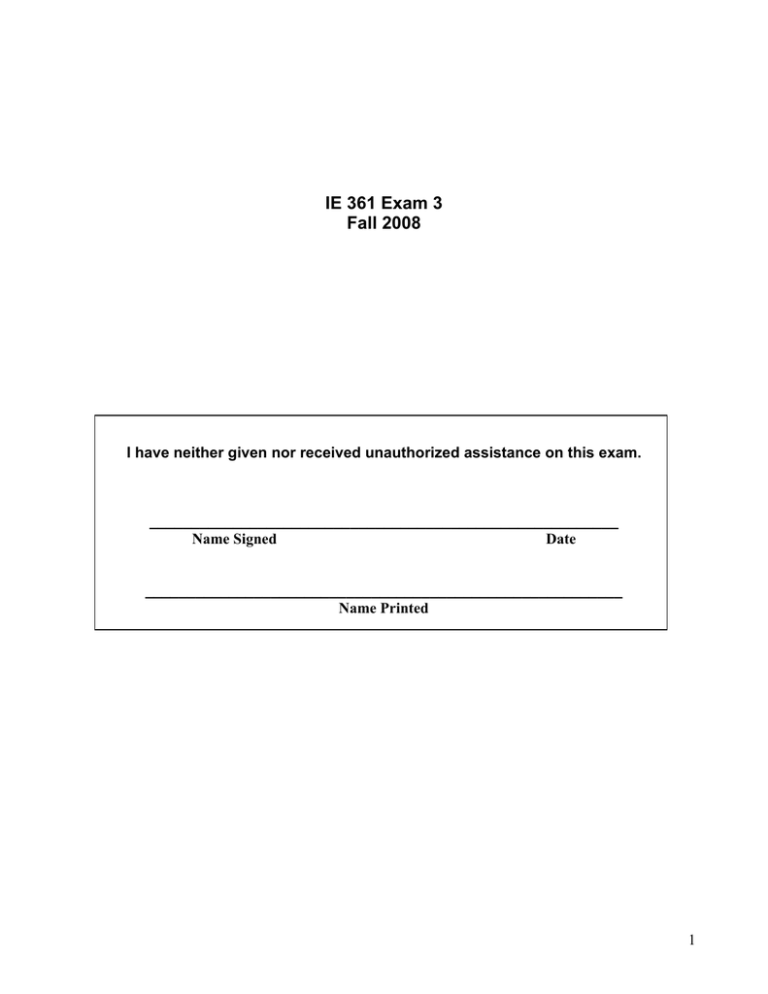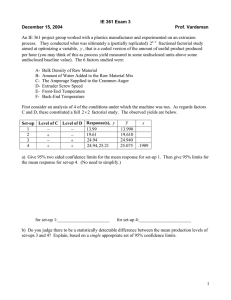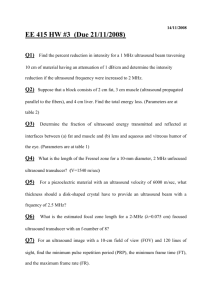IE 361 Exam 3 Fall 2008
advertisement

IE 361 Exam 3 Fall 2008 I have neither given nor received unauthorized assistance on this exam. ________________________________________________________ Name Signed Date _________________________________________________________ Name Printed 1 This exam consists of 20 multiple choice questions. There is a single best answer for each question. Circle EXACTLY ONE response for each question on this answer sheet. 1. A B C D E 2. A B C D E 3. A B C D E 4. A B C D E 5. A B C D E 6. A B C D E 7. A B C D E 8. A B C D E 9. A B C D E 10. A B C D E 11. A B C D E 12. A B C D E 13. A B C D E 14. A B C D E 15. A B C D E 16. A B C D E 17. A B C D E 18. A B C D E 19. A B C D E 20. A B C D E 2 The 1983 article "On the Propagation of Error in Air Pollution Measurements" by Evans, Cooper and Kinney uses as an example the measurement of the concentration of particles in air as determined by a high-volume air sampler (that draws air through a highly effective filter). This quantity is D C= F ⋅T where D is the change in mass of the filter over the collection period (in μ g ), F is the average flow rate during the collections period (in m3 / min ), and T is the length of the collection period (in min ). Representative means and standard deviations for the variables D, F , and T (derived from a Harvard School of Public Health study of air pollution and lung function) were as below. Variable Mean D 1.34 × 105 1.50 F T 1.44 × 103 Standard Deviation 571 .106 3.00 1. Based on the values in the table above what " ±2σ uncertainty" do you suggest attaching to a measured concentration of 1.34 ×105 C= = 62.0 μ g/m3 ? 3 1.50 × 1.44 × 10 3 a) 574.1 μ g/m b) 9.6 μ g/m3 c) 8.8 μ g/m3 d) all of the values in a) through c) are too small. e) all of the values in a) through c) are too big. 2. Uncertainty in which measured quantity seems to be the largest contributor to uncertainty in measured concentration? a) D b) F c) T d) Not enough information has been provided to identify the biggest contributor. 3. In order to set inspection limits on the weights of packages of small nominally identical "widgets," a project group weighs n = 20 sets of m = 100 of these widgets. The n = 20 weights (of groups of 100 widgets) produced in the study have sample mean 100.0g and standard deviation 1.0g. Ignoring the weight of packaging (which would additionally need to be accounted for) it is sensible to set a lower inspection weight limit for packages of (NOT 100, but rather) 25 of these widgets (that might be used to make a rapid check that enough widgets have been included in a package) at a) ⎡⎣ 25 − 2 (1.0 ) ⎤⎦ g b) ⎡⎣ 25 − 2 (.5 ) ⎤⎦ g c) ⎡⎣ 25 − 2 (.2 ) ⎤⎦ g d) ⎡⎣ 25 − 2 (.1) ⎤⎦ g e) 25g 3 The article "Factorial Design of Experiments Applied to Reliability Assessment in Discontinuity Mapping by Ultrasound" by Kruger, da Silva, and Rebello reports on a study intended to improve a variable y = a measure of infidelity of an ultrasound image (of a fixed and known 3-d geometry with sharp edges) (small y are good) based on some choices of the details of how ultrasound scanning is done. Below are some summary statistics for repeat scans under 4 different physical set-ups processed using what we will call Algorithm #1 to convert the ultrasound signals to an image. Set-up #1 n1 = 2 Set-up #2 n2 = 2 Set-up #3 n3 = 2 Set-up #4 n4 = 2 y1 = 2.55 s1 = .07 y2 = 11.40 s2 = 4.95 y3 = 5.40 s3 = 1.13 y4 = 8.15 s4 = 1.20 4. If one adopts a "one way normal model" (with constant standard deviation) as a description of y , an estimate of the standard deviation of this measure of image infidelity for any fixed set-up using Algorithm #1 a) is 1.84 with 4 degrees of freedom. b) is 2.61 with 4 degrees of freedom. c) is 1.84 with 8 degrees of freedom. d) is 2.61 with 8 degrees of freedom. e) None of a) through d) is a correct completion of the sentence. 5. Set-ups #2 and #4 differ only in whether or not "Filtering" was enabled on the ultrasonic pulser/receiver. For judging whether there is there clear evidence that the mean infidelity measures for the two set-ups differ, one should compare a) 11.40 to t ⋅ spooled (.71) and 8.15 to t ⋅ spooled (.71) . b) 11.40 to t ⋅ spooled and 8.15 to t ⋅ spooled . c) 11.40 − 8.15 to t ⋅ spooled (.71) . d) 11.40 − 8.15 to t ⋅ spooled . e) None of a) through d) is a correct completion of the sentence. 1 6. An estimated standard deviation of Lˆ = ( y1 + y2 + y3 + y4 ) is 4 a) .35spooled b) .50spooled c) .71spooled d) 1.41spooled e) none of a) through d). As a matter of fact, the 4 Set-ups represented above have 2 × 2 factorial structure. Set-ups #1 and #2 employed no filtering while #3 and #4 used it. Set-ups #1 and #3 used a 5 MHz transducer while #2 and #4 employed a 10 MHz transducer. The 4 means from the table above are plotted on an interaction plot on the following figure. 4 As it turns out, appropriate 95% "margins of error" for the means plotted above are ± 5.1 . 7. Based on the plotted means, a) fitted "Filtering" main effects are smaller in magnitude than fitted "Transducer" main effects. b) fitted "Filtering by Transducer" interactions are so small as to not be visible. c) the fitted overall mean y.. is near 0. d) None of a), b) and c) are correct completions of the sentence. e) Exactly two of a), b) and c) are correct completions of the sentence. 8. Based on the plotted means and the 95% margins of error, a) "Filtering" main effects are clearly statistically detectable. b) "Transducer" main effects are clearly statistically detectable. c) "Filtering by Transducer" interactions are clearly statistically detectable. d) None of a), b) and c) are correct completions of the sentence. e) Exactly two of a), b) and c) are correct completions of the sentence. 9. If the present ± 5.1 margins of error for the plotted means were considered too large to allow adequate understanding of the effects of the "Filtering" and "Transducer" factors, one might collect additional data. Which of the following are true about such data collection? a) Additional data collection for the 4 Set-ups would necessarily eventually provide substantially smaller margins of error for the means. b) Additional data collection for the 4 Set-ups would necessarily eventually provide substantially smaller values of spooled . c) Enough additional data collection would necessarily eventually make all main effects and interactions statistically detectable. d) Exactly two of responses a), b), and c) are correct. e) All of responses a), b), and c) are correct. The ultrasound study actually involved not only the factors "Filtering," and "Transducer," but the factor "Algorithm" as well (a second algorithm was also used to convert ultrasound signals to images). Although the article is not explicit on this point, we will assume that each physical ultrasound scan was processed using only one of the algorithms. A summary of all the data collected in the study is on the next page. 5 Combination (1) a b ab c ac bc abc Level of A (Transducer) 5 MHz 10 MHz 5 MHz 10 MHz 5 MHz 10 MHz 5 MHz 10 MHz Level of B (Filtering) without without with with without without with with Level of C (Algorithm) 1 1 1 1 2 2 2 2 y s 2.55 11.40 5.40 8.15 11.30 21.15 15.50 18.40 .07 4.95 1.13 1.20 .42 .07 .14 2.82 All sample sizes represented by the table are m = 2 , and here spooled = 2.11 with 8 degrees of freedom. 10. It is fairly obvious from the above table (and before any formal analysis) that (at least for this object scanned using this equipment in the present fashion) a) the second algorithm is worse than the first. b) the second algorithm produces more consistent results in terms of this measure of image infidelity than the first and a "constant σ " assumption may not be a great one here. c) Both a) and b) are correct completions of the sentence. d) Neither a) nor b) is a correct completion of the sentence. Even if you considered b) of 10. to be correct, henceforth operate under a constant standard deviation model. 11. A " ± margin of error" to associate with any of the sample means in the table above based on 95% confidence limits a) is 2.43 . b) is 3.44 . c) is 4.87 . d) is smaller in magnitude than a) above. e) is larger in magnitude than c) above. The "Cycle #2" column in the usual table made when using the Yates algorithm is below. 27.50 66.35 11.60 12.75 −.40 1.45 −6.10 −6.95 Complete the Yates algorithm and use your results in what follows. 6 12. The sign of a2 produced by the Yates algorithm a) is negative, but this has no practical interpretation. b) is positive, but this has no practical interpretation. c) is negative and indicates that the 10 MHz transducer produced better (smaller) values of y overall. d) is positive and indicates that the 10 MHz transducer produced worse (bigger) values of y overall. 13. The " ± margin of error" for any of the fitted effects you computed (based on 95% two-sided confidence limits) a) is 1.22 b) is 2.44 c) is 4.88 d) is smaller than a) above. e) is larger than c) above. 14. Regardless of how you answered 13., apply a ±1.0 margin of error criterion and judge which 23 factorial effects are detectable. These are a) the overall mean, A, B, and C main effects only. b) the overall mean, A and B main effects only. c) the overall mean, A and C main effects only. d) the overall mean, B and C main effects only. e) the overall mean, A and C main effects and AB interactions. 15. Using a fitted model that includes only A and C main effects and AB interactions, what value of y should one predict for a scan of the test geometry using a 5 MHz transducer, no filtering, and the first algorithm? a) 2.07 b) 2.20 c) 2.55 d) 3.83 e) None of a) through d) is close to being correct. Now suppose hypothetically (not because this was the case in the actual study) that there were 2 additional factors 2-level factors, D and E, with levels varied in the collection of the data represented at the top of page 6. In fact, suppose that the 8 set-ups indicated there as regards levels of A,B, and C, had corresponding levels of D and E derived from the choice of generators D ↔ AB and E ↔ AC 16. In this hypothetical scenario, what levels of D and E were used in the collection of the data represented on the first row of the table on page 6? a) low D and low E b) low D and high E c) high D and low E d) high D and high E e) It is impossible to tell from the given information. 7 17. The choice of generators D ↔ AB and E ↔ AC means that in the analysis of experimental results a) every effect will have 3 aliases. b) the D main effect is confounded with only the AB 2-factor interaction. c) the A main effect is confounded with only the BD and EC 2-factor interactions. d) the E main effect is confounded the AC 2-factor interaction and 2 other 25 factorial effects. e) Exactly 2 of a) through d) are correct completions of the sentence. 18. If I judge the fitted sums of effects that appear on the 1st, 2nd, 4th and 5th rows of the last column of the Yates calculations to be statistically detectable, in this hypothetical context the simplest interpretation available is that a) the overall mean and A, C, and D main effects are detectable. b) the overall mean and A and C main effects and AB interactions are detectable. c) the overall mean and A main effects and DE interactions and CD interactions are detectable. d) None of a), b), and c) is a correct completion of the sentence. 19. Making the simplest possible interpretation of the outcome that the fitted sums of effects that appear on the 1st, 2nd, 4th and 5th rows of the last column of the Yates calculations are statistically detectable, what mean y do you predict for the 25 combination of levels "de"? a) 2.07 b) 2.20 c) 2.55 d) 3.83 f) None of a) through d) is close to being correct. 20. There is no need to normal plot the 8 values produced by the Yates algorithm in this hypothetical 25− 2 context because a) the central limit theorem already guarantees that sample means y will be approximately normal. b) the method is only useful in full factorial contexts. c) there is replication somewhere in the experiment, so that it's possible to judge statistical detectability using "margins of error" for fitted sums of effects. d) Exactly 2 of responses a) through c) are correct completions of the sentence. e) None of a) through c) are correct completions of the sentence. 8








